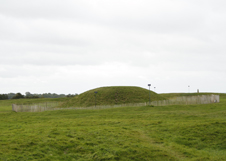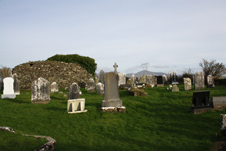|
The
Book of Lismore, containing the written record of the story of "The Siege of Knocklong", was composed around 1480.
It was discovered hidden in the walls of Lismore Castle,
Co. Waterford in 1814.
Approximately in the year 250 ADE,
midway through his reign as High King of Ireland,
Cormac Mac Airt leads his army into Munster to
collect extra taxes and tributes.
Cormac is warned
by his Druids that his claims are unjust and
that his army will be slaughtered. He ignores
all advice.
The Siege of
Knocklong describes the journey of Cormac
and his army southwards. They travel 5 days
and 5 nights, arriving on the Hill of Knocklong
on the sixth morning of travel. They lose a week enroute due to Druid mischief.
Cormac sets up his camp at
Droim Dámhgháire (Knocklong) and
Fiacha sets up at Ceann Chláire (Glenbrohane).
Fiacha Moilleathan, King of Munster, and the
Munstermen resist Cormac's claims.
The siege lasts
over a year and includes five battles between
the opposing armies. When the battles fail to bring the Munstermen to submission, Cormac's druids dry
up all sources of water in the area, and the siege begins.
This act nearly drove the Munstermen
to death. Fiacha turned to the powerful Munster
druid Mug Ruith for aid. He restored
the water. The Munstermen regain their strength and with Mogh Ruith's help, they defeat Cormac
and drive his army out of Munster.
Fiachu and the Munstermen
defeat Cormac and his Northern army at Knocklong.
| The Decision to invade Munster |
|
|
|
The Journey from Claureen to the Slopes of Slieve Felim
Camp 3 Wednesday
The summit of the slope of Formhaol. The army crossed the stream, proceeded past Dubhchoill which is known as Fiodh Damhaiche. From this to Má Leathaird now called Má Tuaiscirt, then on to Crunn-Mhá which is now known as Má Ghabhra, then to Má nUachtair known now as Má Roighne. They made their way into Bocaí Báinfhliucha now called Slievefelim (Sliabh Eibhinne) mountains. They set up camp on the summit of the slope of Fermoyle(above Durrow?. Another Fermoyle close to Kildare town)) (Formhaol na bhFiann) that night. Céacht proceeded westwards to Dubhghleann which is called Gleann Salach [Glansallagh in Co. Cork] today, to meet the druid Art
|
The Journey from Slieve Felim to Ath Cúile Feá /Ath Croí
Camp 4 Thursday
After that they set out again and reached Ath Cúile Feá /Ath Croí that night. Ceathach went to meet the druid Dubhfhois Mac Dofhis at Cúil Fheá Formáile –( Fermoyle Co. Laois? ) |
The Journey from Ath Cúile Feá to Emly
Camp 5 Friday
They continued their march and set up camp that night in Emly (Druim Meáin Mairtine / Ardchluain na Féne / Mucfhalach Mac Dáire Ceirbe) |
Setting up camp on Knocklong Hill
Camp 6 Saturday
Cormac's army arrive at Knocklong Hill/
Cnoc na gCeann / Droim Dámhgháire. |
|
| The Battles at the Ford |
| |
| The Siege Begins. The lakes and rivers are dried up |
| |
| Return Journey to Sliabh Fuait |
| |
| |
| Fiachra's residence at Knockgraffon |
|



